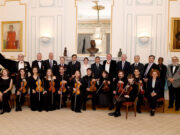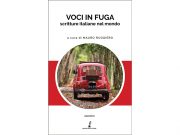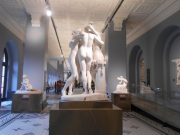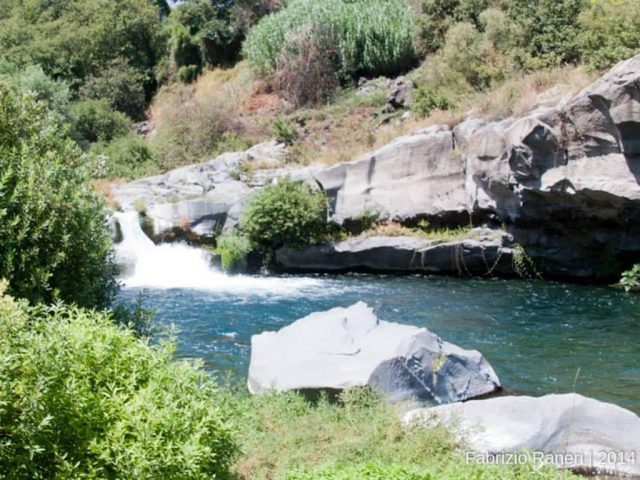A corner of Sicily loved also by Coppola
Although we no longer view rivers as our primary source of survival the way our ancestors did, they still continue to draw humans. They are destinations, historically very important, where tourists flock to or a place of refuge from the summer heat.
Located east of Sicily, the Gole dell’Alcantara (Alcantara is of Arabic origin, al-Qantarah, and refers to a Roman bridge founded by the Arabs. Its literal translation means the gorge of Alcantara) is the most important river in Sicily for many reasons, and one being its perennial flow of water. Rising from the eastern sector of the Nebrodi Mountains known as Nebrodi Park, the source of the Alcantara river can be reached after a fascinating and scenic route with views overlooking Etna and the Aeolian Islands. The total course of the river is 48km with an average slope of 2.3%.
To give you more of a precise idea of location, the river falls within two provinces: Catania and Messina and stretches across the municipalities of Floresta, Santa Domenica Vittoria, Mojo Alcantara, Francavilla di Sicilia, Motta Camastra, Graniti, Gaggi, Calatabiano, Taormina and finally flows to Giardini-Naxos where it meets the sea.
The term Alcantara valley refers to a territory which indicates a very specific geographical area: the ‘catchment area’ of the Alcantara river, that is to say the surface of eastern Sicily that collects rainwater and snowfall that feed the outflow of the river. The physical boundaries of this basin flow to the north, on the ridges of the Peloritani, to the west, on the ridges of the Nebrodi, to the south, on the volcanic soils of Etna and finally, to the east, on the coast of the Ionian Sea. The water of Alcantara, already widely used for irrigation, is now also used for the production of hydroelectric energy which serves to supply energy to all of eastern Sicily.
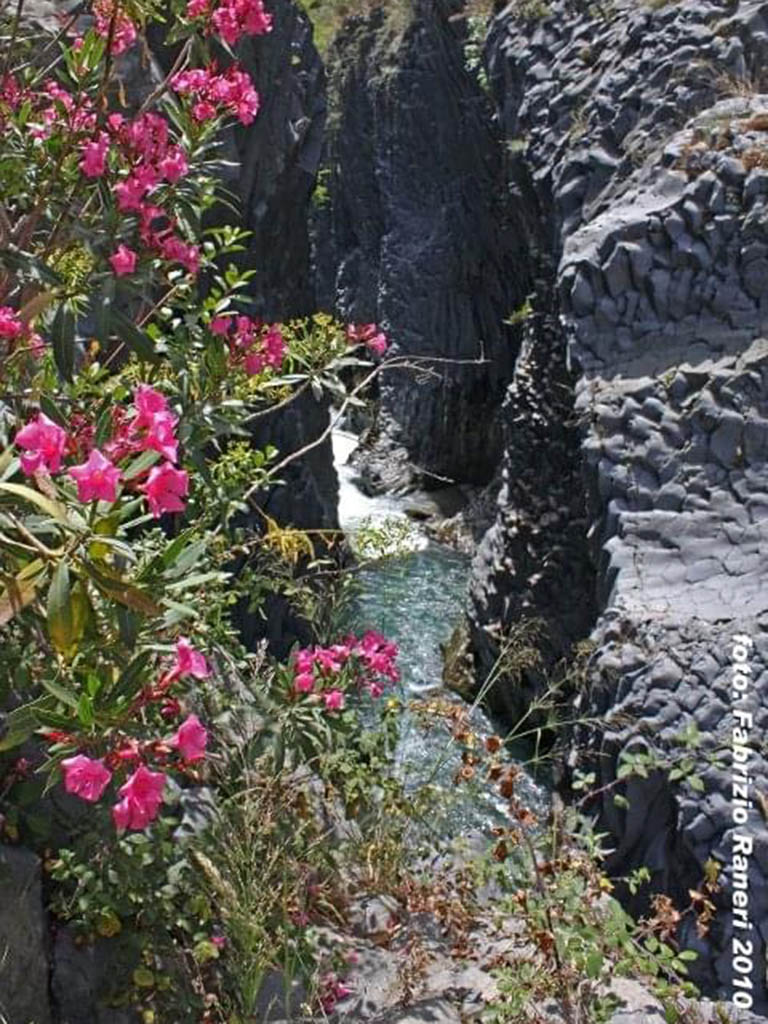
The Gole dell’Alcantara is characterised by huge rough gorges, pockets of cool caves which give you a momentary respite from the scorching heat, cascading waterfalls, distinct ashen lava rocks with smooth and slippery surfaces and ice-cold waters. Even for the most frequent of cold swimmers, the temperature of the Alcantara water leaves an impressionable thumbprint in your memory, especially when you reach parts of the valley where the water is belly deep, causing a rash of goose bumps. You should be concerned at how cold the water is, but not enough to put you off entirely. All of this is wild beauty is over 1,200 metres down and in order to reach the most distinctive and popular part of the valley you need to pay a small entrance fee to the council of Motta Camastra and go down some 200 uneven steps, passing the overgrown prickly pears as you do so.
Rivers are often viewed as physical and in some cases, spiritual sources of sustenance, like all other well know rivers around the world, the Gole dell’Alcantara has, and will continue to serve its territory. The story of this valley is shrouded in a cloud of mythology and history that continue to inspire and beguile travellers. During the ti8me of antiquity, the formation of the Gole was personified as ‘the work of the Gods’ or to be more precise as ‘punishment from the Gods’. One legend tells the story of two peasant brothers, one of the brothers was blind, a good and honest man and the other was dishonest and a cheat, who at the time of the harvest, stole the wheat from his blind brother. The Gods were angered by this and struck a bolt of lightning that killed the dishonest peasant and turned the wheat into a mountain of brown earth that began to erupt so much lava that it covered the valley. It is also said that the waters that run through the gorges are so cold due to the resentment from the God Vulcan towards the goddess Venus who betrayed him. To take revenge for her infidelity, the god, who had previously heated the river for Venus as she loved to bathe there, made the waters ice cold as a punishment. Now of course these are only fictional accounts but does give the valley a rather charming backstory.
What we do know about the Gole is that the riverbed, the part where it meets Motta Camastra, dates as far back as 300,000 years ago. About 8,000 years ago the riverbed was blocked by a lava flow from Mount Etna. As the lava cooled much more quickly by the water than it would have done otherwise, it crystallised in the form of columns. Over the next millennia, the river naturally eroded a channel through these columns, resulting in impressive gorges and ravines which are huge in scale. It is precisely where the river meets Motta Camstra where you can find the most characteristic and impressive parts of the river. Here, you can also find a remarkable lava flow cave, difficult to reach but astounding to look at, called the Grotta dei Cento Cavalli meaning the cave of the hundred horses, which gives you an idea of its enormous size.
Putting history and archaeology aside, the Gole dell’Alcantara holds important memories for locals who spent many days of their childhood playing by the river. “My earliest memory of the Gole was probably in the early 60’s, I used to pass by there on my way to the land. At that time there was only a few cars on the dusty road, maybe some buses. Then in the late 60’s they built the stairs and an entrance which gave people access to the gorge and encouraged tourists to explore the area a bit more,” said one local who grew up in the nearby village of Motta Camastra. “At the age of about 12 or 13, I was spending more time there. I was a little guide for tourists and used to show them around. During this time,” – he continued, “there was a struggle for power as the territory started to bring economic prosperity. There was a shooting, but no one died. About 2 years later, in the early 70’s, a tragedy occurred where a bomb was put underneath a nearby house and unfortunately people died in that case.” Don’t forget this is Godfather territory here which is rather fitting as he told me this story. In roughly the same timeframe, Francis Ford Coppola filmed fragments of part I in the nearby villages of Motta Camastra and Graniti where Michael begins his courtship for Apollonia and also filmed scenes right by the main entrance of the Gole dell’Alcantara. The famous villa where the car explodes killing Apollonia is known as the Castello dei Schavi (Castle of the Slaves) which is located in Fiumefreddo.
Along with Francis Ford Coppola, other great directors chose Sicily and the Alcantara area as a backdrop in their films:
- Johnny Stecchino by Oscar winning director Roberto Benigni was filmed in Letojanni. Benigni also set another one of his masterpieces, The Little Devil in Taormina.
- Star Wars, Episode III: Revenge of the Sith by director George Lucas. The backdrop of the battle sequence between Anakin Skywalker and Obi Wan Kenobi are from the images of the 2002 eruption of Mount Etna.
- Le Grand Bleu by the great director Luc Besson was filmed in Taormina.
- VolevoiPanteloni (also known as Good Girls Don’t Wear Trousers and I Wanted Pants) by Italian director Maurizio Ponzi was filmed in Linguaglossa, PiedimonteEtneo, Fiumefreddo and Randazzo.
- Virilità (also known as Virility) by director Paolo Cavara and filmed in Motta Camastra, Gole Alcantara, Giardini Naxos, Forza D’Agro and Sant’Alessio. The scenes at the Alcantara gorges are among the most beautiful in the film.
- La Terra Trema (also known as The Earth Trembles) by master Italian director Luciano Visconti was filmed at Acitrezza
Even though the Gole dell’Alcantara is clearly popular among filmmakers and tourists which is why it becomes extremely overcrowded in the summer months, the river has never run the risk of becoming un-special. Rather magically it has managed to maintain its wildness and has well and truly earned its place as a natural phenomenon.
Where to stay: Nestled amongst the green olive groves in the charming multiplicity of Motta Camastra lies Villa Marianna Country House. With scenic views overlooking the Alcantara gorges, Mount Etna and the sea of Giardini Naxos, this villa is an ideal base for family and friends to surrender to the peace and quiet whilst still being able to explore the nearby areas of Taormina and Catania. On the ground floor there is a large living room with a fireplace and views overlooking the garden, a bathroom with a shower, air conditioning, double bedroom, heating, TV and a wonderful fully equipped kitchen decorated with Sicilian lava stone. On the first floor you can find an attic room with two double bedrooms and a large bathroom with a shower and bath.The exterior is equipped with a relaxing area on a large terrace, small swimming pool, outdoor dining facilities and private parking.
Villa Marianna can accommodate 6 people. A cot or extra bed is available upon request. Approximately a 45-minute drive from Catania airport, the villa also provides a shuttle to and from the airport at an additional cost.
www.villamarianna.it info@villamarianna.it
Where to eat:Located in Motta Camastra, “Le Mamme del Borgo” is a fantastic way to immerse yourself in Sicily’s culinary culture. A project that combines street food with home cooking, “Le Mamme del Borgo” are a group of mothers who open up their homes to guests and cook outstanding traditional recipes using local ingredients. Guests can participate in the preparation of the dishes, eat together, exchange recipes and chat whilst connecting to the region’s history and traditions. The cooks organize these events on fixed dates or by reservation.
lemammedelborgo.mc@gmail.com | Facebook
If you are looking for something a bit more refined, we suggest heading to the medieval town of Randazzo to Veneziano. With one Michelin star under its belt, you can embark on a serious food journey. Mushrooms dominate the menu which are picked from the nearby Etna Park. Don’t miss the Nebrodi black pig sausage and the wild asparagus- they’re outstanding.
Where to go for a gelato: Pasticceria Gelateria Tavola Calda Bar – “Vincenzino” in the nearby town of Francavilla is the perfect for ice cream and Sicilian pastries. We recommend heading there for breakfast and trying a granita with brioche or as a pit stop for lunch for some arancini.








